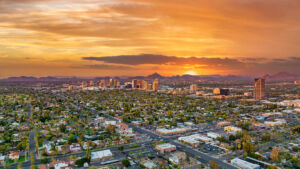Foodie culture and hipster millennials have propelled craft beer into the national spotlight, having a positive sway on national and local commercial real estate markets, according to the Craft Brewing Revolution report released by Cushman & Wakefield.
Cushman & Wakefield reports that “Cool Street” markets, up-and-coming areas within urban communities, where millennials have been drawn to for some time, have been the main beneficiary of this American beer trend.
The number of brewpub establishments in the U.S. has more than doubled between 2006 and 2016, according to the Brewers Association and Cushman & Wakefield. Arizona had a 152.9 percent increase in the number of breweries in five years from 2011 to 2016, the report notes, with 86 craft breweries located in the Grand Canyon State.
The type of beers that are considered craft brew run the gamut. There are the small, independent brewers who have moved from the garage to a commercial space, and there is large venture capital backed operations that create or buy up beer brands, moving into large spaces to fit their needs.
With the wide range of craft brewery types, with different needs, these businesses have an impact on absorption in both the industrial and retail commercial real estate markets.
Many of the local breweries in Arizona are all about staying local and creating community gathering spots. Typically, the best places for craft breweries are within old warehouses and dilapidated retail spots.
Look no further than Phoenix-based SunUp Brewing Co., which opened up in a long-abandoned house along Camelback Road in 2001. Then there’s Wren House Brewing, which operates within a retail space that sat unoccupied for decades.
Huss Brewing Co. opened up a taproom within the Uptown Plaza, which was originally built in the 1950s.
And in Flagstaff, Lumberyard Brewing Co. revitalized a lumber mill that was built in 1890. The space would have been torn down if it weren’t for the brewery’s proposal to rescue the building that sat abandoned since the mid 1990s, says Ken Wilson, president of the Arizona Craft Brewer’s Guild.
But they haven’t been taking up these spaces simply because it’s the cool thing to do. Many of these spaces fit the varying needs of craft brewers.
The biggest want craft breweries need out of their locations is space, and high ceilings, Wilson says, who is also the sales manager at Lumberyard Brewing Co.
At Lumberyard Brewing Company, they have 25-foot ceilings in the old lumber mill the brewery took over. Those ceilings are perfect for stacking kegs and cans, or placing large distillers, Wilson says.
It’s always easier to go up than left to right when you’re in need of extra space, Wilson says.
Craft brewers with large space needs, typically move into industrial assets. They’re able to distribute and brew from the same location.
These brewers are looking large amounts of power industrial spaces can provide, says Joshua P. Wyss, certified supply chain professional at Cushman & Wakefield.
They also need natural gas hook-ups for heating during the brewing process, Wyss says, and breweries need floor drains and lots of sewage and drainage capacity.
Industrial assets are able to meet most of these requirements, especially when it comes to energy needs, Wyss says. But brewers do run into problems finding industrial spaces with adequate sewage and drainage and bathrooms, he mentions.
Meanwhile, operations with restaurant or taproom aspirations have been tracking down retail spaces.
Breweries looking for retail spaces have been great helping landlords fill leftover spaces on their properties, says Chris Hollenbeck, retail expert and managing director at Cushman & Wakefield.
“(Breweries) can take up parts of shopping centers, or retail centers that aren’t as desirable to the typical retail tenant,” Hollenbeck adds.
Brewers are also looking for quasi-industrial spaces, where they can house their brew setup in one area, while putting the restaurant or taproom in the front of the house, Hollenbeck says.
In Arizona, and the Phoenix area, breweries haven’t been having a major impact on absorption for the retail and industrial markets, Hollenbeck and Wyss agree, but every little bit helps, especially when it comes to filling spaces other traditional retailers don’t necessarily want.
Many of these breweries have been filling up spaces in the Downtown Scottsdale and Old Town Scottsdale, Downtown Tempe and Downtown Phoenix areas, Hollenbeck says. Those three communities are the areas where the most breweries are located, he says.
It’s no surprise, since younger populations have been drawn to live, work and play within those submarkets for some time, now. Cushman & Wakefield’s report notes 57 percent of craft beer drinkers are millennials, who only make up 47 percent of the weekly beer drinking population.
Hollenbeck thinks craft brew growth will continue to grow outside of those areas, though. There’s so much demand in areas like Gilbert’s Heritage District, he mentions as one area attracting local and independent places, such as brewpubs.
“I think the same thing is going to start happening in other parts of the Valley, and there will be pent up demand for craft breweries,” Hollenbeck says. “When one opens up and everyone sees how well they do, more and more will follow.”




